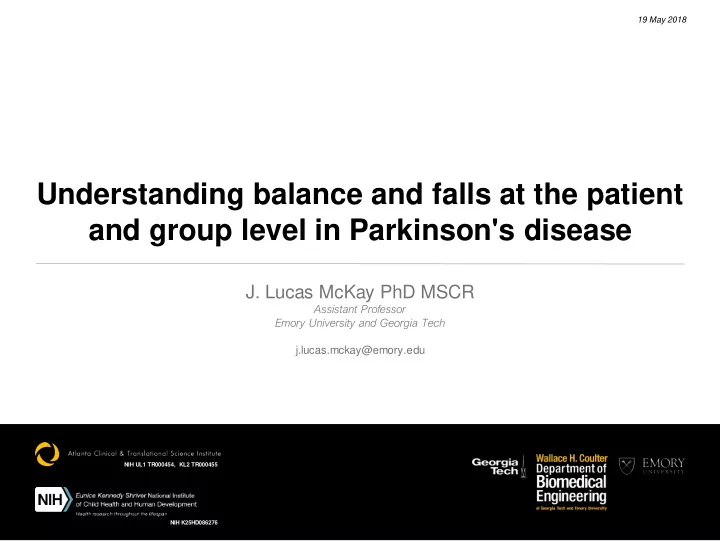

19 May 2018 Understanding balance and falls at the patient and group level in Parkinson's disease J. Lucas McKay PhD MSCR Assistant Professor Emory University and Georgia Tech j.lucas.mckay@emory.edu NIH UL1 TR000454, KL2 TR000455 NIH K25HD086276
My background and trajectory as a translational researcher Electrical Engineering/ Computational Neuroscience Electrical Engineering/ Simulating neuromechanical Computer Science control of balance in animals Circuit design Clinical Research/ Basal Ganglia Neuroscience/ Electrical Engineering/ Movement Disorders Computer Science Understanding Circuit design and simulation balance and falls in PD for brain implants
Understanding balance and falls in PD is critical to informing new therapies • Falls are the main cause of accidental death in individuals ≥ 65, and may indicate the beginning of serious decline. 1 • PD increases fall risk (6 month risk ratio vs. matched healthy adults = 6.1 [2.5 – 15.1]). 2 • There are ways to reduce fall risk in PD. 3,4 • Who will best benefit is unclear, 5 and we cannot send everyone . 6 2 Bloem et al., J Neurol 2001 ; 3 Morris et al. NNR 2015; 4 Sparrow et al. JNPT 2016; 5 Allen et al. Mov Disord Clin Prac 2015 1 Deandrea et al., Epidemiol 2010; 6 Medicare therapy cap: $1,980/year annually for physical and speech therapy combined: medicare.gov
There are many therapeutic options to prevent falls in PD • Many studies use secondary endpoints thought to be precursors to falls such as behavioral scores (BBS, Mini-BESTest) or gait markers (speed or variability) largely for practical reasons. 1,2 • Some recent therapies reported to reduce fall rates: • In-person (but not remote) progressive resistance training coupled with education . 3,4 • In- person “highly challenging” individualized progressive balance training . 5 • Tai Chi (secondary outcome) 6 • Rivastigmine (secondary outcome) 7 1 McKay et al. J Neurol Phys Ther 2016; 2 Henderson EJ et al. Lancet Neurol 2016 3 Morris et al. Neurorehabil Neural Repair 2015; 4 Morris et al. J Physiother 2017 5 Sparrow et al. J Neurol Phys Ther 2016; 6 Li et al. N Engl J Med 2012; 7 Henderson EJ et al. Lancet Neurol 2016
We do not know which patients should be referred to treatment
PD falls predominantly result from inability to control the Center of Mass (CoM) Non-PD (10 Falls) PD (150 Falls) 100 100 80 80 Percent of Falls Percent of Falls 72 60 60 (4% due to FOG 50 40 40 episodes) 40 20 20 10 14 14 0 0 Cause of Fall Cause of Fall Base of Support Base of Support Center of Mass Center of Mass Other Other Bloem et al., J Neurol 2001
I use a perturbation platform to precisely affect the CoM and muscle responses Kinematic Motion Capture Markers Hoehn & Yahr II Surface 12-hour OFF Electromyography MDS-UPDRS III 3.12, Postural Stability: 0/4 MDS-UPDRS III 3.13, Posture: 1/4 Perturbation Platform MDS-UPDRS III Total Score: 34/132 McKay et al., JNPT 2016
I use computational approaches at the patient level to “reverse engineer” balance in individual patients • Simulations to infer activity of motor neurons, brainstem circuits, evaluate biological hypotheses in real patients • Independent variables: medications, DBS, rehabilitation, training • Outcomes: better predictions of fall risk, knowledge about how falls happen McKay et al., JNPT 2016; Allen, McKay et al., J Neurophysiol 2017; McKay et al., in prep
I combine these with epidemiological approaches at the group level to understand fall risk • Cognitive, demographic, clinical covariates critical to understanding fall risk • Large N required to account for patient variability • Current study tracking N=100 patients for 12 months McKay et al., Gait Posture 2018
Thank you! j.lucas.mckay@emory.edu NIH UL1 TR000454, KL2 TR000455 NIH K25HD086276
Recommend
More recommend